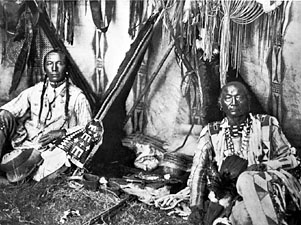Blackfoot
Idaho, United States
city, seat (1885) of Bingham county, southeastern Idaho, U.S., near the confluence of the Snake (Snake River) and Blackfoot (Blackfoot River) rivers. Founded on the Utah Northern Railroad in 1878 at the northern edge of Fort Hall Indian Reservation (1869), the city evolved as the centre of an irrigated agricultural (chiefly potato-growing) area. Development was stimulated by the establishment in 1949 of the National Reactor Testing Station (now Idaho National Engineering Laboratory), 32 miles (51 km) to the northwest. Nearby is the site of the original Fort Hall trading post built in 1834 by Boston merchant Nathaniel Wyeth and operated from 1838 to 1856 by the Hudson's Bay Company. Inc. 1907. Pop. (1990) 9,646; (2000) 10,419.
people
 group of three closely related Algonquian (Algonquian languages)-speaking North American Indian tribes, comprising the Piegan, or Pikuni, the Blood, or Kainah, and the Siksika, or Blackfoot-proper (often referred to as the Northern Blackfoot). The three groups traditionally lived in what is now Alberta, Can., and Montana, U.S.
group of three closely related Algonquian (Algonquian languages)-speaking North American Indian tribes, comprising the Piegan, or Pikuni, the Blood, or Kainah, and the Siksika, or Blackfoot-proper (often referred to as the Northern Blackfoot). The three groups traditionally lived in what is now Alberta, Can., and Montana, U.S. Among the first Algonquians to move westward from timberland to open grassland, the Blackfoot probably migrated on foot using wooden travois drawn by dogs to transport their goods. In the early 18th century they were pedestrian buffalo hunters living in the Saskatchewan valley about 400 miles (645 km) east of the Rocky Mountains. They acquired horses and firearms before 1750. Driving weaker tribes before them, the Blackfoot pushed westward to the Rockies and southward into what is now Montana. At the height of their power, in the first half of the 19th century, they held a vast territory extending from northern Saskatchewan to the southernmost headwaters of the Missouri River.
Among the first Algonquians to move westward from timberland to open grassland, the Blackfoot probably migrated on foot using wooden travois drawn by dogs to transport their goods. In the early 18th century they were pedestrian buffalo hunters living in the Saskatchewan valley about 400 miles (645 km) east of the Rocky Mountains. They acquired horses and firearms before 1750. Driving weaker tribes before them, the Blackfoot pushed westward to the Rockies and southward into what is now Montana. At the height of their power, in the first half of the 19th century, they held a vast territory extending from northern Saskatchewan to the southernmost headwaters of the Missouri River.The Blackfoot were known as one of the strongest and most aggressive military powers on the northwestern Plains. For a quarter of a century after 1806, they prevented British, French, and American fur traders, whom they regarded as poachers, from trapping in the rich beaver country of the upper tributaries of the Missouri. At the same time, they warred upon neighbouring tribes, capturing horses and taking captives.
Each Blackfoot tribe was divided into several hunting bands led by one or more chiefs. These bands wintered separately in sheltered river valleys. In summer they gathered in a great encampment to observe the Sun Dance, the principal tribal religious ceremony. Many individuals owned elaborate medicine bundles—collections of sacred objects that, when properly venerated, were said to bring success in war and hunting and protection against sickness and misfortune.
For three decades after their first treaty with the United States in 1855, the Blackfoot declined to forsake hunting in favour of farming. When the buffalo were almost exterminated in the early 1880s, nearly one-quarter of the Piegan died of starvation. Thereafter the Blackfoot took up farming and ranching.
Early 21st-century population estimates indicated some 90,000 individuals of Blackfoot descent in Canada and the United States.